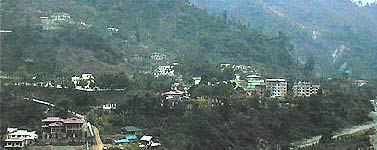 |
Bhutan's
Economy |
|
 |
Bhutan Information |
|
|
 |
|
Bhutan's commercial hub
- Phuentsholing in an urban dilemma |
 |

|
|
Kabreytar:
Phuentsholing's fastest growing suburb
|
|
Phuentsholing,
Bhutan's commercial hub, is one of fastest growing towns in Bhutan. High
concentration of people and vehicles almost rub each other for space. The
space problem is also aggravated by the growth of the neighbouring border
town of Jaigaon.
But,
in the past few years, some sections of the town's population have drifted
away from the city limits, acquired vast stretches of land in the suburbs
and constructed big buildings. |
|
One
such place is Kabretar, about five kilometres from the town centre with
only a dirt road leading towards it. A stranger in the town would have
no idea that the stony and pot-holed road led to a cluster of high-rise
buildings and plush bungalows quietly nestled within the once thick undergrowth.
Kabretar, once a quiet place, has become a beehive of activity.
top
|
Phuentsholing,
Bhutan's commercial hub
|
 |
Kabretar's growth
In
Kabretar scores of labourers from Jaigaon are engaged in constructing new
buildings, some complete and some halfway. In the early 70s Kabretar was
teeming with citrus mandarin orchard but by the end of the seventies ,
the productivity from the orchards decreased and villagers resorted to
farming. Framers plant dal, maize, gingers and wild potatoes. But by the
early late eighties most of the villagers in Kabretar found it easier to
sell some portions of their lands and live off the proceeds. A lot of farmers
sold their land. And as a testimony the single-storied house, built at
a cost of about Nu 1,800 in 1978, still stands strong. Within a short span
of time the price of land in Kabretar sky-rocketed, from about Nu 1,300
for half an acre in 1974 to about Nu 6,000 a decimal today. Farmers built
instead of single-story house a new double-storied building by selling
their land. Their buildings are rented out to eager tenants.
The high rent
and shortage of apartments in the Phuentsholing proper is another reason
behind the growth of Kabretar where many people come seeking cheap accommodation.
"I pay Nu 3,000 for my place while the same would cost nearly double in
Phuentsholing," said one of the tenants. Another said that he was willing
to travel the long and dusty road everyday because the rent, Nu 2,500 for
two rooms, a kitchen and a toilet, was a good bargain. Meanwhile, the dzongkhag
has stopped further constructions until soil stability and other necessary
surveys are done. "There are more than 20 buildings and bungalows in Kabretar
as of now but I can bet that many more would come up in the near future,"
said an old resident of Kabretar. "Changes are wont to happen but I never
knew it would be this fast and in this manner," he added.
top
|
Urban
poverty: Stark realities
|
 |
An
urban poverty study undertaken recently says that although there is little
or no abject poverty in the country, urban poverty is an emerging phenomenon
in Bhutan. The study carried out by the ministry of communications and
the central statistical organisation along with a Danish consultancy firm
states that migrants from rural areas constitute the bulk of the poor and
low-income group in urban areas. The draft report highlights the high rate
of rural urban migration, shortage and rising cost of land and housing,
and lack of sufficient urban services as conditions that breed urban poverty.
According to the report, the urban poor are also vulnerable to eviction
and loss of livelihood.
In Thimphu, among the 140 households covered during
the survey, 43 percent of school children had completed primary education
while 40 percent were illiterate. In Phuentsholing, however, 65 percent
of the children were illiterate. The report, which is divided into quantitative
and qualitative parts, states that the qualitative part consists of interviews
with three categories of people - key informants, the focus group, and
case studies. The draft report further states that "the case studies do
not claim to be representative of poverty study in Bhutan."
"Case
studies are part of the qualitative input which have been selected in a
way that focuses on characteristics of poverty and how society has reacted
to the behavior of poor individuals or groups," it says. The case studies
are respondents' perception of poverty and the report says that "what people
tell may not be in agreement with the rules and regulations of the country."
Six enumerators had carried out the survey in a total of 240 households
in Thimphu and Phuentsholing.
| Contributed
by KUENSEL, Bhutan's National Newspaper |
 |
| Information on Bhutan |
 |
|


